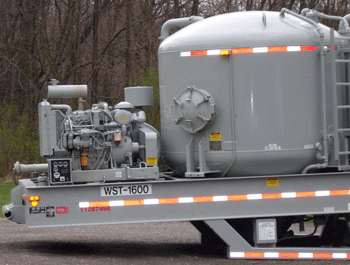Chemicals
From Wikimarcellus
(Difference between revisions)
| Revision as of 05:53, 3 April 2009 Tcopley (Talk | contribs) (→Resources - summary of fracking chemicals) ← Previous diff |
Revision as of 02:19, 15 April 2009 Tcopley (Talk | contribs) (added frac tank photo) Next diff → |
||
| Line 1: | Line 1: | ||
| + | <center>http://www.sonic.net/~tcopley/img/frac_chem_tank_sm.gif <br>'''[[Halliburton]] frac fluid tank'''<br>The Clean Drinking Water Act in 2005<br> exempts disclosing the ingredients of the chemical stew<br> used to frac gas wells<br>Photo credit - donnan.com[http://donnan.com/]</center> | ||
| + | |||
| Examples of (toxic) chemicals used in [[Hydro-fracturing]] include benzene, toluene, ethyl benzene and xylene. Their use obviously raises concerns. | Examples of (toxic) chemicals used in [[Hydro-fracturing]] include benzene, toluene, ethyl benzene and xylene. Their use obviously raises concerns. | ||
Revision as of 02:19, 15 April 2009

Halliburton frac fluid tank
The Clean Drinking Water Act in 2005
exempts disclosing the ingredients of the chemical stew
used to frac gas wells
Photo credit - donnan.com[1]
Examples of (toxic) chemicals used in Hydro-fracturing include benzene, toluene, ethyl benzene and xylene. Their use obviously raises concerns.
When water samples are analyzed from well water or other sources, signs it is tainted with fracing fluid chemicals may include unusual readings on:
- alkalinity
- aluminum
- barium
- calcium
- iron
- hardness
- manganese
- pH
- potassium
- specific conductivity
- sodium
- total dissolved solids.
Resources
PA Dept. of Environmental Protection “Summary of Hydraulic Fracture Solutions.” [2]

